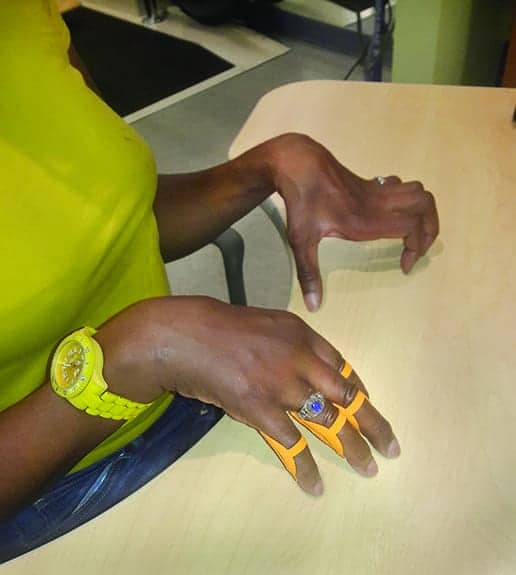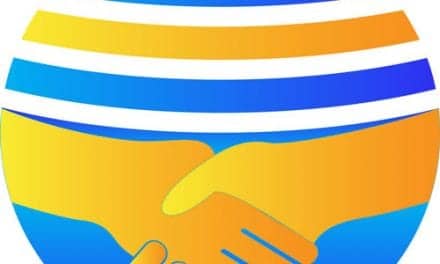
Sandra Salinas, OTR/CHT, assists a client with a simulated utensil holder created with a 3D printing device. The 3D printing technology can also be useful for printing medical models for patient education.
by Sandra Salinas, OTR/CHT
It was Heraclitus who wrote extensively about the only constant being change and, while the Greek philosopher has been dead for nearly 2,500 years, his words still ring true for today’s occupational therapists. That’s because change, and the need for adaptability, have always been part of our profession’s DNA.
Modern-day occupational therapy (OT) was born from necessity, with injured World War I soldiers requiring the help of reconstruction aids to return to their civilian lives. Using available materials and ingenuity, these OT pioneers worked to rebuild both physical and psychological aspects of the individuals under their care.
A hundred years later, the mission of OTs is still about finding new ways to meet the individualized needs of their clients in a meaningful way, despite the challenges that arise.
The Internet allows therapists to use smartphones to find products that would assist patients, but this comes as hospital budgets are constricting and shelf space for storing adaptive equipment is limited. Where once practicing therapists would create customized orthotic devices, sew slings, and use materials to make writing aids, today the lack of insurance reimbursement for fabrication time and the adaptive aids available on the web make these skills much less a priority for OT professionals. These developments have, in a way, meant therapists are doing less integration of adaptive equipment into patient care.
Wouldn’t it be nice to have a Star Trek replicator to create whatever we need on demand? A simple device in which one places a particular object and, with the push of a button, the object is reproduced. Such a device would be most desirable among OT departments. And, though the technology of Star Trek hasn’t become available yet, it certainly is getting closer.
Utilizing Technology to Improve Care
At Memorial Hospital Miramar in South Florida, the core team of three therapists (Physical Therapist Oscar Ancajima, Pediatric Occupational Therapist Kristian Porko, and myself) use 3D printing to improve outcomes for clients. Custom adaptive equipment, such as utensil holders and writing aids, increase independence, as do precision-sized hand and finger orthotics. We’ve printed models of a knee prosthetic, elbow joints, and the inner ear to educate patients and created fidget toys help children focus. “3D” has even helped organize the clinic, with printed hooks keeping sports cords contained and accessible.
Considering the benefits this team has been able to provide by having this device at its disposal, the question becomes not whether a facility should have a 3D printer, but how can therapists make sure the facility gets one?
Not Without Challenges
The adoption of any new technology usually comes with obstacles. The expense of the equipment has to be justified, and formulating a strategy for incorporating the new tool can be difficult in clinics where space and time are already in short supply. Directors and financial officers must also buy in.
Additionally, the printers have some basic requirements that must be considered, including the need for a hospital-grade connection for the electrical systems and an Internet-connected computer for web access, saving STL files, downloading compatible slicing programs, and transferring converted g-code files. Special moisture-resistant containers to hold the filament must be purchased, as well as tools for post-production of models after they’re removed from the print bed surface.
As far as start-up human costs, there has to be at least one staff member who will embrace learning about and sharing with others the benefits of the equipment. A champion who spearheads the use of the printer and keeps it from gathering dust.
We’ve learned the most important first step for that person is to understand the process and terminology involved in 3D printing. There are many web-based sources (blogs, articles, etc) that can provide this information in addition to “how to” books. The printer manufacturers also provide educational resources on their websites.
Therapists may also find useful learning tools and groups on social media. Our regional professional organization, Florida OT Region 7, supports a Facebook page open to therapists. Visitors to that page share articles about how 3D printing is being utilized in cost-efficient ways, what clinicians are having success printing, and links useful to those working in the field.
But the path from novice to expert is still filled with lots of trial and error, and that’s OK. Users need to be open to innovating within the technology to determine how it best applies to their clients and situation. At Memorial Hospital Miramar’s outpatient therapy clinic, therapists made many prints and found some simply did not work well; while others that were tried have been wonderful additions to the facility.

Custom-fitted finger PIP braces created using a 3D printing device. The cost for 10 braces is approximately $1.
Making the Case
Most OT professionals will testify that one-size-fits-all models usually, in fact, do not fit all. Armed with that reality, therapists used it to help demonstrate the financial benefit of 3D printing. Memorial Hospital Miramar is a community hospital, serving people regardless of their financial or insurance status, and commercial finger orthotics that come in preset sizes traditionally cost about $25 per orthosis.
For a 3D-printed orthosis, patients are measured for an exact fit and can select the color they prefer. It takes only a few minutes to take measurements, an hour for the printer to make the model, and a few minutes of therapist time to refine the print to be ready for use. While the time required to measure, educate the patient, and order the finger orthotics is about the same for both a prefabricated orthosis or custom one, the real savings come on the bottom line where the final 3D print costs only a dime. That saves Memorial Hospital Miramar $24.90 on each finger orthosis.
We’re also saving money when printing medical models for patient education. This facility’s therapists use an anatomical knee model to facilitate understanding of and compliance with postsurgery therapy. A commercially purchased knee model costs $250 or more; whereas the knee replacement model fabricated here costs $54 worth of material.
Life-Changing Impact
While the cost savings are important—and critical in getting the go-ahead from the financial side of a facility—the therapist’s currency are the lives we impact. Take, for example, the universal cuff used by spinal cord-injured patients. It’s a simple design that holds eating utensils when the person can’t do it themselves because of weak hand grasp. The problem, however, is that a second person must be there to place the cuff on the individual.
To help with this situation, we found a design for a client that allowed her to use the grasp she had and take it on and off her hand by herself. After 4 months of using the 3D-printed device, she was able to grasp a spoon without it. Another client, this one with a hereditary peripheral neuropathy, wanted to once again play her piano, something the “claw hand” position of her fingers prevented. The custom-fitted finger PIP braces (cost: $1 for all 10) the therapists printed allows her to tickle the ivories once again.
Moving Forward
While the learning curve all clinics face is how to best integrate 3D printing into daily operations, there is no doubt the technology is here to stay. There are now maker stations in public libraries, and universities have integrated it into the curriculum of OT technology classes. It will be the job of currently practicing therapists to propel the use of printing equipment into clinics, share knowledge with colleagues, and collaborate with designers in the community who have a common interest in sharing expertise to help others.
A modern-day philosopher, Bob Dylan, once sang, “The times they are a-changin’.” When that means including 3D printing in the occupational therapist’s toolbox, it can be a game-changer for clients, clinics, and the profession. RM
Sandra Salinas, OTR/CHT, is the supervisor of rehabilitation services and an occupational therapist at Memorial Hospital Miramar. She has more than 36 years of experience with adult rehabilitation and is a certified hand therapist. Salinas has presented courses about the use of 3D printing in therapy and is involved with further developing the technology within the Memorial Healthcare System. For more information, contact [email protected].



